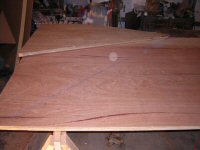16 foot single wheel unusual TD build
Re: 16 foot single wheel unusual TD build
I had the same initial thought. But on thinking it over if the two yoke ends are solidly secured / welded to the tow vehicle and the the trailer there will be no rotational motion around the longitudinal axis like there is when used in a driveshaft. The u-joint will then provide lateral movement (turning) as well as up / down movement. I'm uncertain if there will be any binding when a turn involves a dip for example. Would a double cardan joint be better, worse or unnecessary???
That will be some long turning circle though with the rear wheel way back there; might be a learning curve when corners on narrow roads.
That will be some long turning circle though with the rear wheel way back there; might be a learning curve when corners on narrow roads.
Our 6x12 deep vee nose cargo trailer camper conversion... viewtopic.php?f=42&t=58336
We have a small off grid cabin we built ourselves in the NM mountains; small PV solar system; 624 watts PV, Outback CC & inverter/charger ... http://countryplans.com/smf/index.php?topic=2335.0
We have a small off grid cabin we built ourselves in the NM mountains; small PV solar system; 624 watts PV, Outback CC & inverter/charger ... http://countryplans.com/smf/index.php?topic=2335.0
-

MtnDon - 2000 Club

- Posts: 2200
- Images: 24
- Joined: Sun Aug 19, 2012 10:57 pm
- Location: New Mexico
Re: 16 foot single wheel unusual TD build
If my single foamie had a "regular" ball and socket trailer hitch, it would do just that. Since the foamy is not perfectly balanced, it would just flop around the hitch like a fish out of water. A ball and socket joint like a trailer hitch has too many degrees of freedom. It pivots side to side (like when you are making a turn) and it pivots up and down (like when the TV enters a steep driveway) and it also rotates around the long axis of the trailer. It can't rotate 360 degrees of course, because the receiver socket will hit the tongue base where the ball screws in-but it can rotate partially. A universal joint does not posses this rotational degree of freedom. It is constrained in that plane. So a universal will pivot side to side and up and down but it can't rotate by design. Look at my pix with the universal joint. In your mind's eye, pivot it side to side and up and down. Now try wringing it like a wet dish rag. You can't. When you twist the right yoke, the left yoke twists right along with it. So the TV and trailer rotate equally along the long axis of the rig. They mimic each others angulation. If I'm driving down the road and I'm in a stiff cross wind from the passenger side, my TV will list to port and so will my trailer. If the wind is from the drivers side, the TV will list to starboard again, at the same angle as the trailer. A universal joint cannot allow a differential rotation between the two vehicles. Can you see that?
-

WeirdDogGuy - Teardrop Advisor
- Posts: 79
- Images: 13
- Joined: Tue Apr 15, 2014 5:21 pm

 At yield.
At yield.

